Saving the Harvest
Posted on Tuesday, August 30, 2022 · Leave a Comment
Now is the time when gardeners often have too much fresh produce. People joke about locking their cars to keep neighbors from placing unneeded zucchinis in them. Our mothers and grandmothers labored over hot stoves on hot days to put up tomatoes in jars for winter, or making jam. Now there are better, easier ways to preserve the harvest. Let’s have a look.
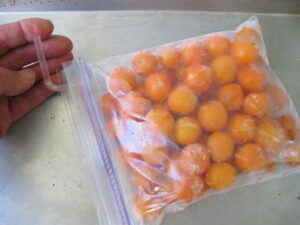
A straw used to remove air from a bag of cherry tomatoes
I keep tomato products for later use in a number of ways. First and easiest, I freeze tomatoes whole. I put clean tomatoes in zipper bags and freeze them whole. Later, when I want tomatoes for a soup or stew, I just run hot water from the tap into a big bowl and drop in a few tomatoes. That softens them up so I can easily chop them, but it also loosens the skins. I just rub the skins with my fingers, and skin comes off. A few minutes later I chop them and they are just like canned tomatoes.
Want tomatoes for winter sandwiches? Cut them in thick slices and roast them on a sheet pan at 350 degrees until most of the moisture has gone. Then cool and place in zipper bags for storage in the freezer. When you need a tasty tomato in your sandwich, take a few slices out, and cook slightly in a toaster oven to thaw it.
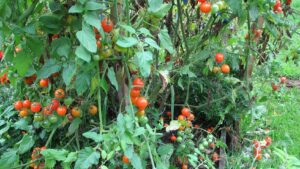
Sun Gold tomatoes are very prolific and dry well for storage.
I grow many hundreds of cherry tomatoes each summer. I plant a dozen or more ‘Sun Gold’ cherry tomato plants each year, and each produces a bounty of rich, golden nuggets of flavor. What do I do with all those? I cut them in half and dry them in a food dehydrator, cut side up. When dry they will keep well in the pantry (or the freezer) in a wide-mouth quart jar. I toss a handful into every soup or stew I make.
Of course you can slice and dehydrate any kind of tomato. I have a friend who slices tomatoes, dries them until they are very crisp, and then grinds them in a food processor to make dried tomato flakes. She sprinkles the flakes into or on to a wide range of dishes. And she usually gives me a pint of them each year, which I treasure – I use it to add that mystical “umami” flavor to a dish.
A few words about food dehydrators. I have lots of experience with two good ones: NESCO American Harvest is a round dehydrator that will allow you to add many extra trays (up to 30, but with much increased drying time). NESCO dehydrators come with either top or bottom heat, so drying time is a bit uneven. The other is Excalibur, a square one with 9 trays. These blow air across the trays, and everything gets dry at once. They both have thermostats and timers that will turn them off when desired.
I use my dehydrators for drying apples and pears that are great for snacking. I cut slices about 3/8 inch thick and bag them up for snacking while they are still chewy. It looks like I will have a great grape harvest this year, and I may try making raisins. Set temperature at 125 to 135 degrees so you don’t break down vitamins.
I also use a dehydrator for drying hot peppers until they are brittle, then I grind them up in my coffee grinder to make hot pepper powder. That way I can sprinkle a little or a lot into a recipe, depending on who will be sharing dinner with me – I like food spicy.
I make tomato paste each summer, but that is more like the hard work my Grandmother did. I core the tomatoes and squeeze out excess juice and seeds, then cut them in half and drop into the Cuisinart. I run it until the tomatoes are a slurry. Then I pour the slurry into a heavy enameled cook pot. I heat it slowly, allowing the mixture to just slowly simmer (to avoid burning it).
It takes a couple of hours to fill the big kettle, and all evening for it to boil off the excess liquid. When I can literally stand up a soup spoon in the mix, I know it I thick enough. I leave the pot on the counter all night to let it cool and evaporate some more, and then in the morning I spoon the paste into ice cube trays and freeze. I put the cubes in bags or jars. It is nice to never need to remember to buy tomato paste – and to have a good use for damage tomatoes that might otherwise end up in the compost. I cut out the bad spots, and use every one.
I have never gotten excited about making jams or jellies. But if you have a dedicated freezer for storage, you can cook your raspberries or blueberries with sugar and spices, then freeze them. The canning process is lengthy and messy, so I generally avoid it. If you just want a little jam, make 3 or 4 jars and store in the fridge. It will be as tasty – and it gives you an excuse to spread some on ice cream, using it up before it get moldy.
Of course, storing food is the easiest, cheapest way to eat the harvest long after it. Winter squashes like butternut and blue Hubbard store for months in a cool, dry location. They store well for months under the bed in a guest bedroom with the radiators turned off.
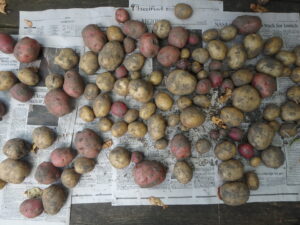
Cure potatoes for a few days before storing.
When digging potatoes or pulling onions, try to do it in a dry time (not hard this summer). Lower moisture levels are better for storage. Cure them for a few days in a breezy place out of the sun. Store potatoes, carrots, celeriac and rutabagas in a place between 35 and 50 degrees with high humidity. Garlic and onions like lower humidity with cool temperatures. Sweet potatoes should never go in the fridge – they need to be stored in a warm room like the kitchen.
I try to eat something I grew every day of the year, and mostly I do that. Dried herbs, garlic and frozen foods are always there for me to use, so I do.
Henry gardens and cooks in Cornish Flat, NH. Reach him at
henry.homeyer@comcast.net. He is a regular speaker at libraries and garden clubs, and the author of 4 gardening books.
Giving Thanks
Posted on Tuesday, November 10, 2020 · Leave a Comment

Candelabra primroses delight me each June
I think it’s important to take time to count my blessings. I try to take time each day to reflect on how grateful I am for living the life I do. And on a sunny afternoon near Thanksgiving I like to sit outside and reflect on everything I have to be grateful for. Here are some thoughts about my life, and how gardening helps to make my life full, satisfying – and rich in flowers and vegetables.
I am grateful to have a loving family and wonderful friends. On July 1 of this year Cindy Heath and I got married, after 11 years of partnership. Our family and friends attended via Zoom. Cindy is a wonderful person, an accomplished fiber artist and a terrific gardener. Not only that, she loves to weed! The gardens here in Cornish Flat have never been so well tended. I am so grateful to have her in my life.
I am very pleased to have a newspaper column that has kept me writing and learning for 22 years. On November 11, 1998 my first gardening column appeared in the Valley News of West Lebanon, NH. In that article I reflected then on how important it is to clean up the garden each fall, and to get rid of weeds before their seeds get in the soil.

My ‘Merrill magnolia blooms magnificently each April
I also noted that “As insects may have laid their eggs on or in vine crops, tomatoes and potatoes, it is not a good idea to compost these plants.” Diseased or insect-prone plants I recommended for the burn pile or the household trash – or perhaps a pile in a far corner of the property, well away from garden beds. I am happy that our vegetable garden is fully cleaned up and put to bed.
I am grateful for my gardens. My huge ‘Merrill’ magnolia tree that blooms with a thousand white blossoms on my birthday in April. The primrose garden with hundreds of blossoms in the shade of old wild apple trees in June. The peonies that are seemingly everywhere. Milkweed that attracts and nourishes the gorgeous Monarch butterflies. Fall asters, and so many more.

I am grateful for bright red geraniums on my windowsills
Although this may sound silly, I am grateful to have so many potted geraniums in the house. This year we brought in all our geraniums ( Pelargonium spp., not to be confused with perennial geraniums of a different plant family that winters just fine outdoors). They sit on bright windowsills and will bloom off and on all winter, and go outside next summer. Their bright red blossoms give me joy.
I am happy and grateful that I have a small crape myrtle tree in a pot, and have learned how to overwinter it indoors. I bought it in Florida in 2018 and brought it home as carry-on luggage.

My crape myrtle is a source of joy
Last winter I brought it indoors and overwintered it in our cold, dark basement that stays in the 35 to 50 degree range. I didn’t think it would survive, but it did and bloomed magnificently this summer. The fall foliage was a great red, the leaves dropped, and it has now settled in for its winter rest.

Freezing tomatoes extends the season feeding me even in winter for which I am grateful
I am grateful that we have put up so much food for the coming months. We froze lots of whole tomatoes in zipper bags for use in soups and stews, along with dried cherry tomatoes and some tomato sauce. What else is in the freezer? Lots of leeks, zucchini, kale, Hubbard squash, beets, blueberries and peppers.
I’m happy to have good farm stands nearby. I only had a few peppers this year, so I bought half a bushel from Edgewater Farm in Plainfield, NH at the end of the year. They are great farmers who use the IPM method: Integrated Pest Management. As IPM farmers, they use many of the techniques of organic farmers but reserve the right to use pesticides if a crop is in danger. I prefer to buy organic produce, but trust them to use the least toxic chemicals, and only if necessary. I buy my corn from them and I am always pleased when I get a corn worm: it means that they did not have to spray.

Snowdrops are the first of the bulb flowers to bloom in Spring, and always make me happy when they appear in March
I am happy and grateful that I have been able to plant bulbs each fall for decades. Winters are long here, and the thought of all those little balls of energy waiting in the soil for the onset of spring to come up and share beauty with me makes me happy.
At age 74 I like to point out that I will make it through another winter just because I want to see what else did. I regularly take chances with plants that are not supposed to be hardy in my climatic zone. This year I planted a cut-leaf Japanese red maple, a variety called ’ Tamukeyama’. The cut-leaf varieties are generally less hardy than the standard varieties, of which I have three.
The grower of our Tamukeyama, John Lyon of Newbury, NH (Lyon Family Nursery) told me it is one of the hardiest varieties. We’ll see. I’m happy to have it, and if it does not survive a cold winter, so be it. Although I have never done this before, I will protect it from the wind with a little A-frame shelter made of plywood. I do love the plant.
I am happy and grateful for you, my readers. Each week I get nice e-mails or thoughtful hand-written notes thanking me for sharing my knowledge and sharing personal experiences, and only occasionally disputing my assertions. When my corgi, Daphne, passed away last summer, I was inundated with messages of sympathy. Thank you. Please write to tell me what you are grateful for, where you live, and if I can quote you in a future column.
Lastly, I am grateful that all the newspapers that carry my column are still in business. Subscribe! Buy the paper. Donate to the paper if you get it free. Advertise if you have a business. Local newspapers are the lifeblood of our communities.
Queen of the Garden: the Tomato
Posted on Tuesday, August 4, 2020 · Leave a Comment
Update 8.18.20
I mention garlic and onions in my sauce, but it has been pointed out to me that sauce with those ingredients needs to be cooked in a pressure cooker at 240 degrees for 10 minutes to avoid botulism.
My mother and grandmother slaved over a hot stove in August and September to can whole tomatoes or to make sauce and store it in jars. I rarely do. Mainly I freeze tomatoes whole. I call them my “red rocks” and store them in zipper bags for use in soups and stews.
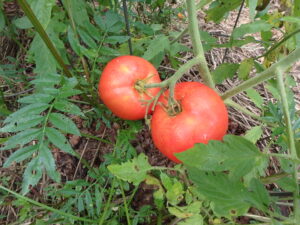
My first slicers are Jet Star and early hybrid
To prepare red rocks I simply rinse them off, allow them to dry, and slip them into gallon freezer-grade plastic bags. I use a straw to suck the air out of the bag after I have the zipper closed 99% of the way. That minimizes frost on the tomatoes in the freezer.
To use frozen tomatoes, I just run hot water from the faucet over them. The skin thaws quickly, and rubs right off. Or I’ll drop a few in a pan of hot water. That helps to thaw the tomatoes and makes them easier to chop up for use. If I freeze cherry tomatoes, I don’t bother removing the skins before cooking with them.
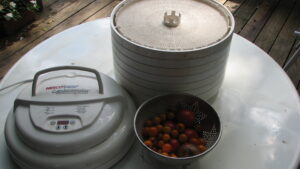
NESCO Dehydrator
I have a couple of food dehydrators that I use to dry tomatoes, too. The Cadillac of dehydrators is the Excalibur. Mine is a $300 deluxe model that blows hot air sideways equally over all 9 trays. My other is the NESCO American Harvester, a serviceable machine that pushes air up or down through a stack of trays.
The downside to the NESCO model is that you must rotate the trays to get equal drying. And it uses 1000 watts of energy per hour, while the Excalibur uses only 660 watts. Still, at about $125 for the basic machine, it is more affordable. You can stack up to 30 round 15-inch trays over the fan and heating element, but the more trays you add, the longer it takes to dry all the food. I find about 8 trays is as many as I want to stack.
Most summers I grow 8 to 12 Sun Gold tomato plants, and each is prolific. Most of the fruit I dry in my dehydrators. I cut them in half and dry, cut side up. I store them in zipper bags in the fridge or freezer, and use them in soups and stews. Dried tomatoes can be stored in the pantry, too.
Sometimes I dry plum or slicing tomatoes. I cut them about 3/8 of an inch thick. They tend to stick to the trays, so be sure to buy the special no-stick screens to put on the trays. That makes clean up much easier.
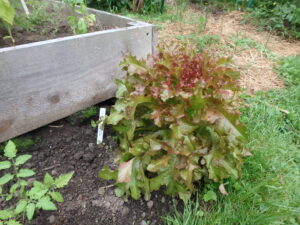
It’s time to plant more lettuce to go with the tomatoes
A sandwich is not really a sandwich, for me, without slices of tomato. One way to save slices of tomato for winter use is to roast them. I do so in the oven at low heat until they are caramelized and soft, not tough and dry. Then I place them in zipper bags and freeze them – but just one layer of tomatoes per bag. When I crave a tomato in my sandwich, I pull out a few slices and heat in my toaster oven until warm. Not a fresh tomato, but better than most sold in the grocery store in January.
I also make tomato paste. Lots of paste. I store it by freezing it in ice cube trays, and then putting it in zipper bags when frozen. No more half-used cans of purchased paste going fuzzy in the fridge for me.
To make paste I use imperfect tomatoes – and I usually have plenty. I cut out the bad spots, then core them. I squeeze the cored tomatoes in the sink, which gets rid of most seeds and lots of juice. Then I quarter them and place in a food processor. I puree them, then add to a large enameled iron pot and cook them slowly for hours. I know they are done when I can literally stand up a spoon in the pot. I let it sit all night, uncovered, to cool and lose some more water. In the morning I spoon the paste in the ice cube trays. When frozen, I empty the trays and put cubes in zipper bags.
Canning tomato sauce the old fashioned way is hard work and takes hours of work. Part of that work is blending the tomatoes and herbs, salt and pepper to get the flavor and consistency just right. In addition to pureed tomatoes I use onions, garlic basil, oregano, parsley and thyme. I cook it for 45 minutes or so, as I like it nice and thick.
But then there is the canning itself. First you have to boil the jars and lids to sterilize them. Once filled with cooked sauce, one needs to boil the sauce in sealed jars to kill botulism, a potentially fatal disease. Forty minutes at a rolling boil is recommended. All in all, making 7 jars of sauce – which is what a canning pot can hold – takes an evening.
The Lazy Guy technique for making sauce is to freeze it, not can it. I have an aversion to using plastic for storing food, but make an exception for tomato sauce. I have quart plastic containers with screw tops, though one can also use zipper bags. Since I have 2 large freezers, I have plenty of space for garden produce.
People raise their eyebrows when I tell them I grow between 35 and 50 tomato plants each year. But since I eat my own stored tomatoes all year, I can barely grow enough of the Queen of the Garden.
Henry lives and gardens in Cornish Flat, NH. He is the author of 4 gardening books, and is a 20-plus-year veteran of the UNH Master Gardener program. Reach him at
henry.homeyer@comcast.net.
Eating From the Garden Every Day of the Year
Posted on Tuesday, November 20, 2018 · Leave a Comment
For breakfast I often drink a green smoothie that includes a banana, kale, some OJ, half a lime, fresh ginger, fresh mint if I have it, and water. It’s healthy, tasty, and uses kale I grew. I usually pick fresh ‘Winterbor’ kale from my garden until mid-December as even temperatures in the 20’s don’t seem to bother it. But all winter I have bags of frozen kale I can chop and add to my morning drinks – and winter stews.
Having a spare freezer – or more than one – is a wonderful way to keep eating from the garden all year. Here’s what I have in mine right now: tomatoes, peppers, green beans, broccoli, kale, strawberries, blueberries, leeks, apples for pies, peaches, applesauce and plum puree.
Tomatoes dominate the freezer. I freeze them whole, skins on, and make sauce or use them the way I would canned tomatoes. The skins come off easily – I just drop them into a pan of hot tap water for a couple of minutes, then rub the skins off. Of course you can leave the skins on, if you want.
I also have homemade tomato sauce in the freezer, complete with onions, garlic, basil, oregano and other herbs. And then there are the bags of tomato paste I cook down from tomatoes that I cut up, puree in a blender, and boil down till very thick. I freeze the paste in ice cube trays, then transfer the cubes to zipper bags when frozen.
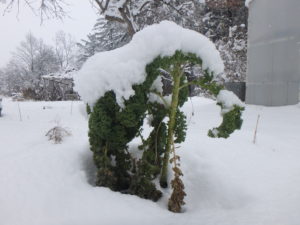
Kale is a good winter veggie
Freezing does take some work. I blanch kale, beets, broccoli, squash and green beans before I freeze them. That means I drop them in boiling water for a minute or so, put them in cold water, and then dry them well before freezing. The quick boiling kills the enzymes that cause aging, making for a better product. I don’t blanch tomatoes, peppers, fruit or leeks. But for best results it is good to eat those in year one, not year four or five.
The easiest way to keep food for eating all winter is to store it in a cool location. I have a cold basement and a cool area in the entry area of my house. Potatoes, carrots, kohlrabi and rutabagas store well in the basement with high humidity and temperatures in the 33 to 50 degree range.
When I have lots of root crops I store them in a cement block bin with a plywood lid. The bin is big enough for six 5-gallon pails. It keeps out the mice, holds in the humidity, and keeps the vegetables at a relatively constant temperature. I keep an indoor-outdoor thermometer sensor in it, so I can monitor the temperature from upstairs. If it gets too cold, I plug in an electric heat mat I also use for starting seedlings. I put a little moist sand in the bottom of each bucket to help with the humidity.
Other veggies need low humidity and cool temperatures. Those include onions, shallots, garlic and winter squash. I keep them on a wooden rack I got from Gardeners Supply, their “orchard rack”. I have that in the main part of the house where I have a woodstove – hence low humidity. But I keep them near the mudroom, which is unheated, so they stay cool. You can also keep squash under the bed upstairs in a spare bedroom with the heat off and the door closed.

Excalibur dryer does a good job on cherry tomatoes and more
Lastly, I dehydrate cherry tomatoes, hot peppers and apples. I find the drying process tends to concentrate flavors. I cut the cherry tomatoes in half, set the thermostat at 130 degrees, and bag them up when dry, but not brittle. Hot peppers I dry till brittle, and then grind them in my coffee grinder. That way I can add just a little zing to a dish, and avoid hot chunks. I grind the pepper seeds, too.
So here is a good winter stew made from my own veggies. You can add a pound of sausage or stew beef to this or leave it as a vegetarian dish. I do it both ways. If you use meat, brown it first in oil, then drain any excess oil and add the veggies.
Chop 2 yellow onions coarsely and brown in a cast iron pot. Then add the root vegetables according to what you have and what you like: 5 medium carrots cut in rounds (about 2 cups), 1 cup rutabaga cut in ½ inch cubes, 1 cup kohlrabi peeled and cut in ½ inch cubes, ½ to 1 cup celeriac, finely chopped. If you have no celeriac, substitute celery, they are relatives with the same flavor. Potatoes will go in the stew at the end, as they tend to fall apart if cooked too long.
Next add 5 frozen tomatoes, skinned and coarsely chopped. If you don’t have your own, add a 28 oz. can of crushed tomatoes, preferably organic. Add 3 to 4 cups water or broth, and perhaps a cup of apple cider. Add 1 to 2 cups chopped kale if you like kale. Simmer.
Garlic tends to burn easily if added with the onions, so add it after the liquid to avoid that. Use 1 to 3 cloves garlic, crushed or chopped fine.
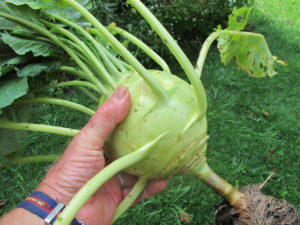
Kohlrabi is a good winter keeper
Next add herbs, according to your supply – and your taste. I have frozen parsley, and chop a couple of tablespoons of it. I add fresh rosemary from a plant on the window sill, a nice sprig chopped fine. A tablespoon of Herbs de Provence from the Coop is good, too. Then I add some ground hot pepper to add some zing. Simmer.
Lastly I add 2 cups potatoes cut in ½ inch cubes that have been boiled for 10 minutes in a separate pot. Drain, and add to the stew. Simmer another 10 minutes and serve. Enjoy!
Henry is the author of 4 gardening books and has been a UNH Master Gardener for over 20 years.
Tomatoes: Getting the Best from Your Harvest
Posted on Tuesday, August 21, 2018 · Leave a Comment
This is my favorite time of the year. Tomato time. Tomato sandwiches for breakfast and lunch, Tomato, basil and cucumber salads with dinner. Tomatoes in stir fries. Tomatoes going in the freezer, dehydrator and jars of sauce. Oh my, I do love my tomatoes. I grew 35 plants this year, as I usually do.
Many gardeners complain that blights are reducing their harvests. It’s true that 30 years ago we had little blight. We covered our plants against the frost, and they kept on producing until October. Now tomato leaves turn yellow and brown in July, and by August many plants are pretty much bare of leaves. Why, people ask, do the early blossoms produce fruits, but then the plants just stop producing?
I don’t know all the reasons. I do know that most common tomato diseases are caused by soil-borne fungi that winter-over, coming back year after year. You can minimize the problems by rotating your tomato patch each year, or by planting in a new garden space that was lawn. Usually a new garden in full sun will have few problems, but in the following years, the blight will find your tomatoes.
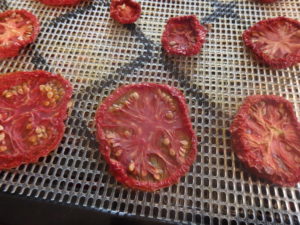
Dehydrated Tomatoes
I have had a good, but not perfect tomato season. I spaced my plants farther apart than I have done in the past, centering them 30 inches or more apart. I planted in the sunniest part of the garden. I cut off diseased branches early and often. And Mother Nature cooperated: June and July were relatively hot and sunny, with low humidity. I had to water early on, but diseases were inhibited by the weather. But now, in August, humidity is high and rain is common. Sigh. My tomatoes are getting blight.
So what do I do with the fruit from 35 plants? For starters I should explain that the trees around my garden have gotten bigger every year, and now my garden only gets sunshine from around 10am to 5pm. That’s considered full sun, but 12 hours is a lot better for production.
The easiest, quickest way to save tomatoes is to freeze them whole for winter. Wash them, make sure they are dry, and put them in gallon freezer-rated zipper bags. I suck the air out of the bags with an ordinary drinking straw. The frozen tomatoes can be used in soups and stews just like canned tomatoes. If you wish to remove the skins, just run the frozen tomato under a stream of hot water and rub off the skin.
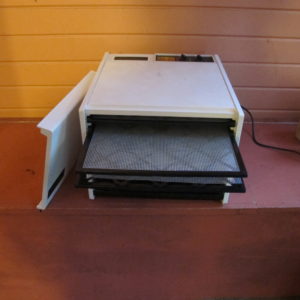
Excalibur dryer
Tomatoes also store well if you dry them in a dehydrator. I plant 6 or more Sun Gold cherry tomatoes each year that produce a lot of fruit. I cut them in half and place them on the racks of a dehydrator and dry them at 130 degrees for 18 hours or so. When they are dry I stuff them into quart zipper bags and keep them in the freezer, though freezing is not really needed. I use the dried nuggets of summer in soups, stews and stir fries. I have even put them in winter sandwiches.
You can also dry full-sized tomatoes. Slice them about 3/8 of an inch thick and place them in a dehydrator. I have two kinds of dryer: the Excalibur, a $300 deluxe model that blows warm air sideways equally over all 8 trays, and the NESCO American Harvester, a serviceable machine that pushes air up or down through a stack of trays.
The downside to the NESCO model is that you must rotate the trays to get equal drying. And it uses 1000 watts of energy per hour, and the Excalibur uses only 660 watts. Still, at about $125 for the basic machine, it is more affordable.
A sandwich is not really a sandwich, for me, without slices of tomato. One way to save slices of tomato for winter use is to roast them. I do so in the oven at low heat until they are caramelized and soft, not tough and dry. Then I place them in zipper bags and freeze them – but just one layer of tomatoes per bag. When I crave a tomato in my sandwich, I pull out a few slices and heat in my toaster oven until warm. Not a fresh tomato, but better than most sold in the grocery store in January.
I also make tomato paste. Lots of paste. I store it by freezing it in ice cube trays, and then putting it in zipper bags when frozen. No more half-used cans of purchased paste going fuzzy in the fridge for me.
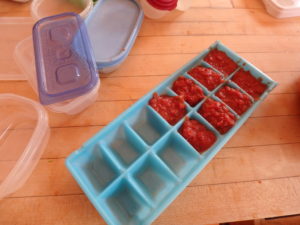
Freeze tomato paste in ice cube trays
To make paste I use imperfect tomatoes, of which I have plenty. I cut out the bad spots, then core them. I squeeze the cored tomatoes in the sink, which gets rid of most seeds and lots of juice. Then I quarter them and place in a food processor. I puree them, then add to a large enameled iron pot and cook them slowly for hours. I know they are done when I can literally stand up a spoon in the pot. I let it sit all night, uncovered, to cool and lose some more water. In the morning I spoon the paste in the ice cube trays.
Canning tomatoes is the old fashioned way. I still put up a few jars of sauce each year, but it’s a lot of work and must be done just right in order to avoid getting sick. Mostly now I make a big batch of sauce and freeze it in plastic freezer containers. But I like seeing jars of canned sauce lined up on a shelf in the pantry- and it connects me to my mom and grandmother.
Henry is the author of 4 gardening books. E-mail him at henry.homeyer@comcast.net. Read his blog posts at https://dailyuv.com/henryhomeyer
Getting Ready for Winter
Posted on Tuesday, August 8, 2017 · Leave a Comment
Here it is, early August and I’ve just picked my first tomatoes, but I’m already thinking about winter. No, I don’t anticipate frost until mid-October or later, but I depend on my garden to feed me much of the year. So I start early getting food processed for storage. I freeze, dehydrate, can and store veggies for winter. Let’s look at tricks you can use to save you time and labor as you save your harvest.
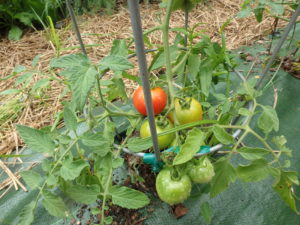
Tomatoes are ripening
Tomatoes are key to almost any soup, stew or stir fry I make, and I don’t want to be buying tomatoes in February, or to depend on cans of sauce processed in factories in California. I want to cook with tomatoes that I grew myself, or that are from a local farmer I trust.
If you grow just a few tomato plants for sandwiches and salads, or even if you planted half a dozen ‘Romas’ for making some sauce, you can have a wealth of tomatoes for freezing if you talk to your local farmer. Most sell “field grade” or “canners” by the bushel at very reasonable prices. They are not as pretty as top grade fruits, but I’ve bought a bushel – 50 pounds –in years when my own crop succumbed early to blight.
Many farmers now grow tomatoes in hoop houses which means they get tomatoes earlier than we do, and they largely avoid blight. So there are times when farmers are practically swimming in tomatoes. That’s when to buy them.
What can you do with 50 pounds of tomatoes? I would freeze most of them. Wash and dry the fruit, then fit them into freezer-grade plastic bags, not storage bags. Freezer-grade bags cost just pennies more per bag, but are much better for the job.

A straw used to remove air from a bag of cherry tomatoes
Suck out any excess air from the bags with a common drinking straw. Just close the bag 99% of the way, suck out the air and snap it closed with 2 fingers – just as you pull out the straw.
Later, to get them ready for use, I run each frozen tomato under hot water while rubbing it gently so that the skin comes right off. After I set it aside for 5 minutes it softens enough for me to cut out the stem attachment point. Then I quarter it, chop it, and put it in the pan.
If you like to make homemade sauce but hate the canning process, just freeze it. Cook up your tomatoes with fresh herbs and onions, and let it cool. Then pack in freezer bags or plastic containers.
I’ve had both front-opening freezers and chest freezers, and I recommend the front-opening ones. It is easy to lose track of what is buried in the bottom of the chest-type freezers. But you’ll find the last bag of kale if it’s on a shelf where you can easily see it. And after a year or two in a freezer, food loses its flavor and often becomes unappealing.

Cube trays
I also freeze ice cube trays filled with my homemade tomato paste. I use my less-perfect tomatoes for paste, which I freeze in ice cube trays. To make paste, I wash tomatoes, and then core them with a paring knife. I squeeze out the seeds and extra juice, which makes for less boiling time and fewer seeds. Then I quarter them and puree them, skins and all, in my food processor.
I cook the puree at low heat in a big enameled cast iron pot (which helps prevent scorching on the bottom of the pot). I know it’s done when I can literally stand up a soupspoon in the paste – after 3 hours or more. I let it cool overnight (or 8 hours) with the cover off the pot, allowing a little more moisture to evaporate. Then I spoon the paste into the ice cubes trays. After they are frozen, I remove the cubes and put them in freezer bags.
Most years I dehydrate several bags of “sun-dried tomatoes”. Except they aren’t sun-dried. They are dried in an electric food dryer. Mostly I dry cherry tomatoes, a variety called ‘Sun Gold’. I cut them in half and place them face up on the screens. It takes from 12 to 24 hours to do a batch, depending on which kind of machine you use, and how juicy your tomatoes are.
I have 2 brands of dryers, a NESCO American Harvester and an Excalibur. The Excalibur uses less electricity (660 watts per hour vs. 1,000 watts per hour) and is more efficient because the flow of hot air goes across the drying screens, not from top to bottom as the NESCO dryer does. But it costs roughly 3 times as much, depending on the model. Both brands are very good.
I also use my dehydrators to dry apples, pears, hot peppers and more. I especially like drying hot peppers because I can get them brittle, and then grind them up in my coffee grinder. That allows me to just add a little in a dish – or a lot if I’m not having company.
So don’t wait until fall. Start putting up food for winter like the proverbial squirrel. Winter is just around the corner.
Henry is the author of 4 gardening books. His web site is www.Gardening-Guy.com. See extra photos for his newspaper articles at https://dailyuv.com/gardeningguy and get daily tips.
Putting Food By
Posted on Wednesday, August 26, 2015 · Leave a Comment
It’s a rare gardener who doesn’t grow at least a few tomatoes. We all love them. I eat them at least twice a day in season, and sometimes I even have one with breakfast. But the season is short, so many of us try to put up tomatoes to have their flavor in winter soups and stews. Our grannies slaved over a hot stove in August and September, canning tomatoes. But have I found freezing them is much easier.
Here’s what I do: I freeze whole tomatoes in zipper bags. I don’t blanch them or remove the skins. All I do is place clean fresh tomatoes in a gallon freezer bag and suck out the air with a straw, sliding out the straw and pinching the bag shut as I do so.
When I want to cook with a tomato, I hold a frozen one under the tap, run hot water over it while rubbing it, and the skin comes right off. I set it aside for a few minutes, then chop it and put in the stew pot. I know it is chemical-free and harvested at peak ripeness. I sometimes freeze cherry tomatoes, and those I toss into the pan with skins on.
In winter I long for tomatoes for my noon sandwich. I’ve found that roasting tomatoes first, then freezing, is a good way to have a substitute for fresh tomato in a sandwich. I thickly slice tomatoes and roast them at 350 degrees until they have given off most of their moisture and caramelized nicely. Then I carefully place them in gallon freezer bags in a single layer. When I need a few slices, I break off the frozen slices and put them in my toaster oven on aluminum foil. I heat them at 350 until thawed. They are not the same as fresh, but they’re the best substitute I’ve found.

A straw used to remove air from a bag of cherry tomatoes
Cherry tomatoes are highly prolific, and I generally have 10 plants or more. Although I eat plenty like candy, right in the garden, I obviously have more than I can eat in August and September. So I cut each in half, and put them in my food dehydrator. I set the thermostat at 125 or 130 degrees, and dry them for 18 to 24 hours, depending on water content and the ambient air’s humidity.
Food dehydrators are great for drying tomatoes, apples, pears, hot peppers and more. My favorite is the Excalibur. It has 9 trays, each 15 inches square, and a fan and heater. It uses 660 watts of electricity per hour, which is less than the 1000 watts used by my previous favorite, the NESCO American Harvester. The Excalibur blows sideways across the trays so everything gets dry at the same rate; the NESCO dehydrator blows from the top or the bottom, and one must rotate the trays to get even drying. The trays near the heater dry quickly, those farther away more slowly.

Tomato paste
I also make a lot of tomato paste. To do this I core full-sized tomatoes over the sink and squeeze out seeds and excess juice. Then I cut them in half and toss them in the food processor, which I use to puree them into a thin gruel. I cook the pureed tomatoes in a big enameled cast iron pot at low heat until the contents are thick enough so that I can stand up a spoon in the pot. It takes 2 to 3 hours of cooking to make paste.
I let the paste cool all night with the pot lid off, so more moisture evaporate by morning. Then I spoon the paste into ice cube trays and freeze them. When hard, I take the cubes out and put in freezer bags. One cube is a very nice quantity to add to a soup or stew. By freezing the paste in small units, there is no can of tomato paste left in the fridge to go moldy and blue. No odd flavors picked up in the fridge, either.
I also make spaghetti sauce. Not much, but I like to have some ready for a quick meal in March. I sauté onions, garlic and fresh green peppers to start with. I add fresh basal, marjoram and parsley from the garden. And of course tomatoes, black pepper and a touch of salt. I can one batch in quart jars each summer – 7 jars – and freeze more in quart yogurt containers. Canning must be done properly, cooking the sealed jars for a long time.
But if you don’t grow enough tomatoes to put up all of them you want for winter, don’t despair. Most farm stands take orders for tomatoes by the bushel at a very reasonable rate, much less than the per pound rate. So when the late blight nailed my tomatoes some years ago, I bought a bushel from a farmer and put them up.
I don’t generally grow a lot of peppers, so I often buy a half bushel of green, yellow and red peppers. I clean and slice them, and freeze in zipper bags. I find they freeze so well that I can even add them to a salad, and having 3 colors of peppers makes a very attractive winter salad. Put them in the salad right out of the freezer and eat soon after.
Gardening is fun, even the weeding. But eating the garden produce is even better. Fresh is best, but come winter, anything is good!
Henry is a gardening consultant and garden designer. He is the author of 4 gardening books and a children’s chapter book. His website it www.Gardening-Guy.com
Tomatoes
Posted on Wednesday, July 30, 2014 · Leave a Comment
This has been, knock on wood, a great year for tomatoes. I planted my seeds indoors earlier than I usually do, which meant that my plants went in to the ground earlier, and bigger. And there were no late frosts, so I’m eating tomatoes earlier than most years. Cherry tomatoes started producing in early July, and I picked my first full sized tomato on July 16. Lots of sun and adequate rain have pushed them along. Barring an attack of late blight, I will have more than I need to feed myself all winter – if I process them now.
My mother and grandmother canned tomatoes. They worked in a hot kitchen in August and September turning homegrown tomatoes into canned tomatoes and sauce. In order to avoid the deadly disease, botulism, they boiled jars seemingly forever. But now, in the day of chest freezers, we can make sauce and not have to go through the canning process. You can make sauce and freeze it for use in the winter. And there are lots of other ways to save the harvest.
First, my favorite technique: freezing tomatoes whole. I call it the “no-work” method. Just place clean dry tomatoes in gallon freezer bags, suck out any excess air with an ordinary straw, and place the bags in the freezer on a cookie sheet. I generally get 9 large tomatoes into a gallon bag. After the tomatoes are frozen, you can take them off the cookie sheets and stack the bags.
When you are ready to use the tomatoes for a soup or stew, you can remove the skins easily, if you wish, by running them under hot water and giving them a quick rub. Halve the tomatoes and cut out their attachment points, chop and cook. If you let the tomatoes thaw they will be mushy and no good for sandwiches. But cooked? They’re great.
Last summer I tried roasting tomatoes in the oven, and was very pleased with the results. I cut tomatoes in half, and placed them in a shallow roasting pan and placed them in the oven at 350 degrees. I cooked them until the tomatoes caramelized and lost most of their moisture. Then I placed them in zipper bags, one layer thick and put them in the freezer. To avoid the need for scrubbing the roasting pan, I cooked them on a sheet of aluminum foil. These tomatoes worked fine in sandwiches in winter. I just put the frozen tomatoes in the toaster oven to thaw and heat, and put them on bread. Yum!

Excalibur dryer
I grow a lot of cherry tomatoes each year – 10 plants or more. I eat them every meal in season, and snack on them between meals. My favorite variety is ‘Sun Gold’, a hybrid. What do I do with the vast numbers of these sweet cuties? For years I have been cutting them in half and dehydrating them. I’ve tried all sorts of dehydrators, and think I have found the best.
The machine I use is the Excalibur. This machine has 9 square trays, a heating element, a thermostat, a timer and a fan that sits behind the trays. The fan and heater location is key. This machine blows hot air across the trays as opposed to all the others I have used, which send hot air up from the bottom or down from the top. Either way, the tomatoes closest to the fan and heating element dry first, and those farther away dry more slowly. So one must rotate the trays, or take out the dry ones and continue to dry those that are still not fully dried.
The Excalibur also uses less electricity – 660 watts an hour, while the NESCO unit I used for years uses 1000 watts – but both take about the same time to dry a batch of tomatoes. The Excalibur also can hold more fruit per tray as the trays are square and the others are round.
I store the dried cherry tomatoes in zipper bags. They are fine on a shelf in the pantry, in the fridge, or, for long term storage, in the freezer. When I want to use them, I just toss them into a stir fry or stew, and these little nuggets bring a “Wow!” to the lips of my guests. If you don’t dry them to the crispy stage, but leave them a little chewy, you can even use them in salads and sandwiches.
Lastly, I make a lot of tomato paste. It’s easy and allows me to use chunks of tomatoes that had bad spots that needed to be cut out. I core tomatoes over the sink and squeeze out juice and seeds. Then I pop them into the food processor and puree them, skins and all. I pour the liquid into a heavy enameled cast iron pot, and slowly boil the slurry until it is thick enough to stand up a spoon in it. I let it cool all night, uncovered, and spoon the paste into ice cube trays. Once it’s frozen I bag it in zipper bags. Then I can get just the right amount of tomato paste and never waste any – I just use 1, 2 or 3 cubes, depending on my recipe.
It is still work to put up the harvest, but the methods above are a lot less work than canning tomatoes in jars in a hot –water bath. And come winter? There is nothing better than eating your own tomatoes.
Henry is the author of 4 gardening books and a children’s fantasy-adventure called Wobar and the Quest for the Magic Calumet. His web site is www.Gardening-Guy.com.
Saving the Harvest
Posted on Wednesday, September 12, 2012 · Leave a Comment
Tomatoes are an important part of my diet. I cook with them year round, and eat them more than once every day in season. My grandmother used to can them, and I still do on occasion, but the easiest thing to do with them is to freeze them whole. No blanching required. Just put clean, dry tomatoes in gallon zipper bags and freeze. Then, when you need tomatoes to cook with, take out a few and run them under hot water in the kitchen sink. Rub and the skins come off. Allow them to sit for a few minutes and they soften enough to chop and use.
I do make tomato sauce, but generally freeze it instead of canning it. I core the tomatoes and squeeze out some of the seeds and water, then puree them in the Cuisinart. I cook the tomatoes with onions, garlic, basil leaves, fennel seed, salt, pepper and whatever other spices appeal to me the day I make it. Sometimes I cheat and stretch my tomatoes by adding pureed zucchini to the sauce. The trick is to cook it enough so that the sauce is rich and thick. A little sugar (or maple syrup) is sometimes needed if the tomatoes are not dead ripe.
I also make tomato paste by cooking down pureed tomatoes until I can stand up a spoon in the mixture. I freeze the paste in ice cube trays, and then transfer it to Ziplock bags.
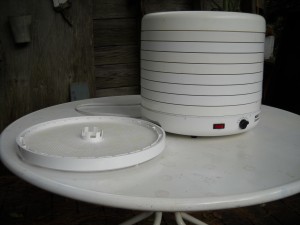
Dehydrator
I dry tomatoes in a dehydrator, making little nuggets of pure tomato flavor for use in winter stews. Although you can use any size tomato, I generally just dry cherry tomatoes. I cut them in half and place on a try, cut side up. It takes about 24 hours to fully dehydrate a batch of cherry tomatoes – but I get about 75 of them on each tray and dry 6 trays or more each batch. Afterwards I put them in zipper bags and store in my freezer. I have plenty of freezer space, but if you don’t, they will store well in the fridge or even in the pantry. I also dry apples, pears and hot peppers most years. I grind my hot peppers in a coffee grinder after they are dry enough to be brittle. Making pepper powder allows me to add just the right amount of zing to a sauce.
My potato harvest was smaller this year than I would have liked, but I have enough for a few months. Potatoes store best between 33 and 50 degrees, with high humidity. An attached garage, bulkhead or unheated mudroom might have the proper temperature. Mice love them, so store them in plastic buckets or storage bins covered with hardware cloth (quarter-inch mesh screening) to keep mice out while allowing good air circulation.
Carrots, beets, rutabagas and celery root (celeriac) store well under the same conditions as potatoes: high humidity and cool temps. All root crops can be stored in the fridge (I keep a spare fridge in the basement), but tend to dry out unless in a drawer. You can leave root crops in the ground until it gets cold outside – although rodents may nibble on them. So if you leave root crops in the ground, check to make sure they are not being eaten.
Carrots store well in the ground. Just cover them with a layer of hay or straw , and then a layer fall leaves. Be sure to place a tall stake in the ground at each end of the row so that you can find the carrots even if we get 3 feet of snow. I’ve stored carrots that way, but found that in years of little snow the ground freezes, making digging difficult. Still, cold temperatures make carrots sweeter. I leave my parsnips in the ground and eat them in the early spring.
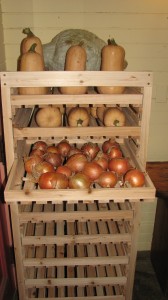
Orchard rack
Cool dry storage is appropriate for winter squash, onions and garlic. Fifty degrees is about right, with low humidity. An upstairs bedroom with the heat turned off is usually good. I have an “orchard rack” from Gardeners Supply that works very well for storing those items. It is made of wood, with slats to allow good air circulation. It is always good to cure or dry onions and winter squash a bit before you put them in their final resting place. I spread them out on the deck in the shade, where they only get morning sun, but get good breezes. That allows them to lose a little water and to harden up a little on the outside.
Freezing veggies is one of the best ways of keeping them. Leafy greens, broccoli, Brussels sprouts, beans and summer squash need to be blanched. That means dropping them into boiling water just long enough to kill the aging enzymes that make them tough and tasteless. Sixty seconds is enough for most things – or until the color changes. Don’t blanch so long your veggies are cooked or mushy. Drop them into a sink of cold water to stop the cooking process as soon as you take them off the stove. I recommend investing in a blanching pot, which has an inner pot with holes, allowing you drain out the water as you lift them out of the bath.
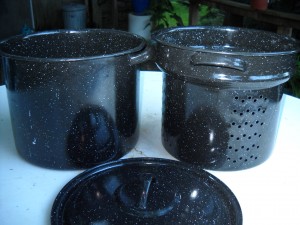
Blanching pot
Once your veggies are cool, spin them dry in a salad spinner and then pat dry with cloth towels. Put them in freezer-grade Ziplock bags, and suck the air out with a straw before closing the zipper all the way. No need to blanch tomatoes, leeks, berries or peppers.
I get great satisfaction from eating my own homegrown food. It takes work at this season, but for me it’s worth it.
A correction: A helpful reader let me know that the moth of the hornworm is not the hummingbird moth. Hornworm moths are as large as hummingbirds, but look different and have different habits. So don’t harm those hummingbird moths!
Henry Homeyer is the author of 4 gardening books. His e-mail is henry.homeyer@comcast.net and his web site is www.Gardening-Guy. com.





























